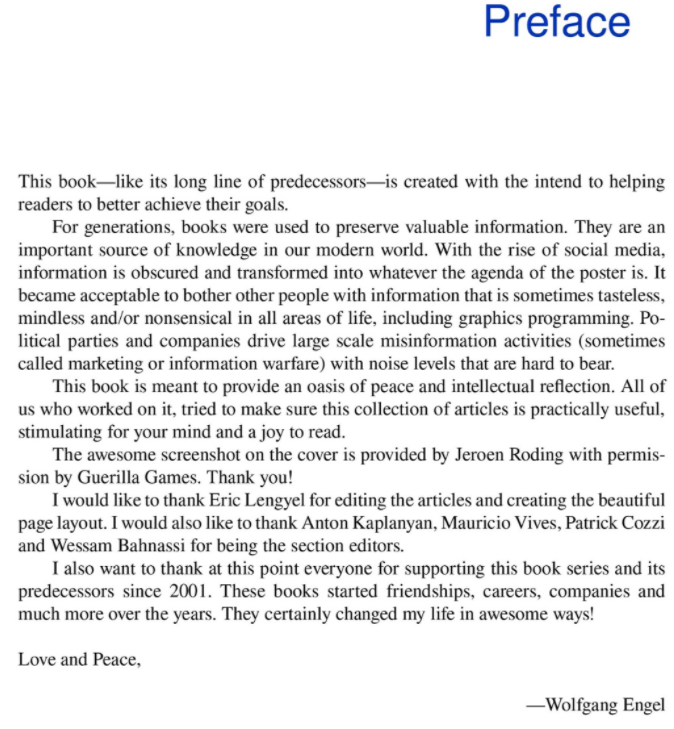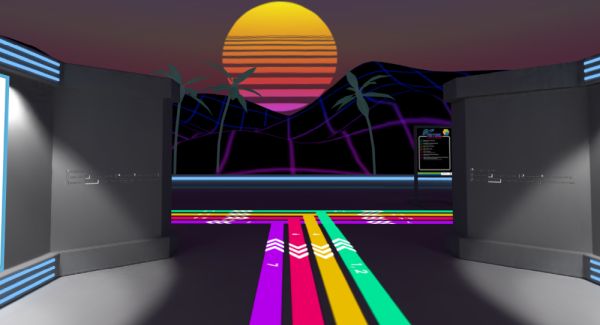From GPU Zen 2 (which you should get), published back in June 2019, which now seems like simpler times:

(thanks to Adam Marrs for noting this Preface)
From GPU Zen 2 (which you should get), published back in June 2019, which now seems like simpler times:

(thanks to Adam Marrs for noting this Preface)
It’s one of the best days of the year, most every year. Happy Public Domain Day, all! “The Great Gatsby” and many more now enters the realm of works we can all (finally) legally build upon, without permission or fee.
The first two are what motivated this post, but the rest are hopefully worth your time:

Two virtual conferences start this coming week of October 5th:
I’ll “attend” both, since they’re both free to me. I’ve never been to SCA – animation is not something I know all that much about (hand-wave about skinning, morph targets, IK, simulation – you now know all I know), but the virtual format gives me an excuse to dip in, especially for the keynotes. The NVIDIA GTC conference has lots of ray-tracing related talks, so I’ll tune in for them. GTC is free to those with .edu and .gov email addresses (and NVIDIA employees).
SCA is also using Discord, like I3D did, and they kindly provide a short introductory video on how to use it. Even without registering, you can download and watch most of the full paper presentations right now, if you like. During the conference itself, 3-minute summary videos will be played for the papers in a session and then discussion will commence. I’ll be interested to see how this format feels. My attention span is short, as is everyone’s (20 minutes is about the absolute maximum), but 3 minutes I can do.
I admit I’ll likely be multitasking, listening and watching only when something catches my attention, so probably will absorb only a small bit of what I’d get if I attended in person. I’m also unlikely to do my homework, reading the papers and watching the presentations, as I’ll mostly be lurking. That’s one advantage of physical conferences: You’re there, and so are “forced” to pay attention. Yes, you can fiddle with your phone or laptop in a “real” talk, but it’s a bit rude and unseemly – why are you even attending? (Well, the answer is, for single-track conferences, that you went to the conference for three sessions in particular, but have time to blow during the other five sessions. I don’t have a great answer for that problem, and admit to the same – it’s hard to pay attention for 6+ hours each day.)
Anyway, take advantage of these *** times and try things out! Figuring out what makes a virtual conference work well and gets people engaged is going to be important for about the next year, sadly enough. But it’s also a chance to find what works well, uses people’s time most effectively and efficiently, and how people who can’t afford the time or money to attend a physical conference can still stay informed.
Maybe make it these three? They’re the “best paper” award winners for this year’s I3D, which (finally) was held, virtually, two weeks ago. I’ve almost recovered. Almost.
In addition to being available on the ACM Digital Library for subscribers, all three of these papers (along with many of the others) are available on the authors’ websites.
I3D 2020 (“ACM SIGGRAPH Symposium on Interactive 3D Graphics and Games” for short) starts this Monday. Here are some pro tips.
And, here’s the registration link (it’s free): https://bit.ly/i3d2020reg – make sure to copy (at least) the Discord information once you’ve registered

I3D 2020 VR poster space
Well, I have about 59 things, but here are the LIFO bits:

SIGGRAPH: don’t forget to cancel your hotel reservation if you have one. Physical SIGGRAPH is gone this year, but your reservation lives on – I just noticed mine was still in the system. If your reservation is like mine, you’ll want to cancel by July 6th or pay a night’s fee penalty. SIGGRAPH is of course virtual this year. August 24-28 is the week scheduled – beyond this, I do not know.
EGSR: It’s happening this week. I should have posted this a few days ago, but it’s all on YouTube, so you haven’t actually missed anything.
The 31st Eurographics Symposium on Rendering will be all virtual and free to attend this year: watch it here. Talks can be watched live or afterwards on YouTube. Full conference program: https://egsr2020.london/program/
Registration is optional, but gets to access to the chat system where you can ask authors questions: https://egsr2020.london/. There’s also two virtual mixers, Wednesday and Thursday: https://egsr2020.london/social-mixers/ – now to determine what 12:00 UTC is… (ah, I think that’s 8 AM U.S. Eastern Time).
HPG 2020: The High-Performance Graphics conference will happen virtually July 13-16. It is free, though there is a nominal fee if you want to attend the interactive Q&A sessions.
I3D 2020: The Symposium on Interactive 3D Graphics and Games is virtual and free to all this year. Dates are September 14-18. Details will be posted here as they become available.
As usual, publications and their related resources for these conferences are added by Ke-Sen Huang to his wonderful pages tracking them.
I’ll update this post as I learn more.
I’ll quote the tweet by Adam Marrs (and please do RT):
Due to the unprecedented worldwide events since announcing Ray Tracing Gems 2, we have decided to adjust submission dates for the book.
Author deadlines have been pushed out by five months. RTG2 will now publish at SIGGRAPH in August 2021, in Los Angeles.
More info here.
To save you a click, here are the key dates:
And if you’re wondering, SIGGRAPH 2021 starts August 1st, 2021.
The key thing in the CFP: “Articles will be primarily judged on practical utility. Though longer articles with novel results are welcome, short practical articles with battle-tested techniques are preferred and highly encouraged.”
It’s nice to see this focus on making the book more about “gems,” concise “here’s how to do this” articles. There are lots of little topics out there covered in (sometimes quite) older books and blogs; it would be nice to not have to read five different ones to learn best practices. So, please do go propose an article. Me, I’m fine if you want to mine The Ray Tracing News, Steve’s Computer Graphics Index, etc.